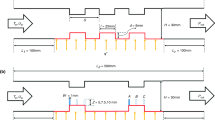Abstract
In this work, numerical analysis was performed to predict the behaviour of high Reynolds number turbulent cross-flows used in film cooling applications. The geometry included one row of three discrete coolant holes inclined at 30 degrees to the main flow. In the computational model, the width of the channel was cut into one sixth and symmetry boundaries were applied in the centreline of the coolant hole and along the line of symmetry between two adjacent holes. One of the main factors that affect the performance of film cooling is the blowing ratio of coolant to the main flow. A blowing ratio equal to two was chosen in this study. Analysis showed that the common practice CFD models that employ RANS equations together with turbulence modelling under predict the film cooling effectiveness up to a factor of four. However, LES method showed better agreement of film cooling effectiveness both in tendency and absolute values compared with experimental results.











Similar content being viewed by others
Abbreviations
- d:
-
diameter of film cooling hole
- DR:
-
jet to mainstream density ratio
- k:
-
Turbulent kinetic energy
- L:
-
length of film cooling hole
- M:
-
Blowing ratio M = ρ c U c /ρ ∞ U ∞
- T:
-
Temperature
- U:
-
velocity component in streamwise direction
- U*:
-
Non-dimensionalized U-velocity = U/U ∞
- u ′∗ :
-
normalized rms U-velocity fluctuations \( =\sqrt{\frac{\sum {\left({u}_{instantaneous_i}-{u}_{avg}\right)}^2}{n}} \)
- V:
-
velocity component in spanwise direction
- VR:
-
jet to mainstream velocity ratio
- W:
-
velocity component in wall-normal direction
- w ′∗ :
-
normalized rms W-velocity fluctuations \( =\sqrt{\frac{\sum {\left({w}_{instantaneous_i}-{w}_{avg}\right)}^2}{n}} \)
- X:
-
streamwise distance from hole leading edge
- Y:
-
spanwise distance from hole centerline
- Z:
-
vertical distance from tunnel floor (flat plate surface)
- ε:
-
Dissipation rate
- ρ:
-
density (average)
- η:
-
Adiabatic Film effectiveness η = (T ∞ − T aw )/(T ∞ − T c )
- θ:
-
dimensionless air temperature θ = (T − T ∞)/(T c − T ∞)
- μ:
-
Dynamic viscosity
- τ:
-
Shear stress
- ¯:
-
mean
- ‘:
-
fluctuating
- ∞ :
-
freestream (or mainstream)
- aw :
-
adiabatic wall
- c :
-
coolant
- LE:
-
Leading Edge
- TE:
-
Trailing Edge
References
Dyson T, Bogard D, Bradshaw SD (2014) Evaluation of CFD simulations of film cooling performance on a turbine vane including conjugate heat transfer effects. Int J Heat Fluid Flow 50, Dec 2014:279–286
Na, S., Zhu, B., Bryden, M., Shih, T. 2006 “CFD analysis of film cooling”; 44th AIAA Aerospace Sciences Meeting and Exhibit; Jan 2006, Nevada; AIAA2006–0022
Silieti M, Kassab A (2009) Film cooling effectiveness: Comparison of adiabatic and conjugate heat transfer CFD models. Int J Therm Sci 48(12, Dec 2009):2237–2248
El-Gabry L, Heidmann J, Ameri A (2010) Penetration characteristics of film-cooling jets at high blowing ratio. AIAA J 48:1020–1024
Heidmann, J. and Ekkad, S. V., 2008 “A novel antivortex turbine film cooling hole concept” Journal of Turbomachinery, Vol. 130, No. 3, Paper 03120
Johnson, P. L., Shyam, V. 2012“Large Eddy Simulation of a Film Cooling Flow Injected from and Inclined Discrete Cylindrical Hole Into a Crossflow With Zero-Pressure Gradient Turbulent Boundary Layer”; NASA/TM-2012-217695
El-Gabry, L., Thurman, D., Poinsatte, Ph., Heidmann, J.; 2011 "Turbulence and Heat Transfer Measurements in an Inclined Large Scale Film Cooling Array – Part I, Velocity and Turbulence Measurements"; Proceedings of ASME Turbo Expo 2011; Vancouver, Canada; Paper No. GT2011–46491
Thurman, D., El-Gabry, L., Poinsatte, Ph., Heidmann, J.; 2011 "Turbulence and Heat Transfer Measurements in an Inclined Large Scale Film Cooling Array – Part II, Temperature and Heat Transfer Measurements"; Proceedings of ASME Turbo Expo 2011; Vancouver, Canada; Paper No. GT2011–46498
Johnson, P.L., Nguyen, C.Q., Ho, S.H., and Kapat, J.S. 2010 “Sensitivity Analysis of Domain Considerations for Numerical Simulations of Film Cooling” Proceedings of the 14th ASME International Heat Transfer Conference, IHTC14–23241
Gu, T., Li, Sh., Liu, J. 2007 “Large Eddy simulation of film cooling” proceedings of the International Conference on PowerEngineering; pp 1419-1422, ISBN 978-3-540-76693-3
Author information
Authors and Affiliations
Corresponding author
Rights and permissions
About this article
Cite this article
Baagherzadeh Hushmandi, N. Large Eddy simulation of flat plate film cooling at high blowing ratio using open FOAM. Heat Mass Transfer 54, 1603–1611 (2018). https://doi.org/10.1007/s00231-017-2225-y
Received:
Accepted:
Published:
Issue Date:
DOI: https://doi.org/10.1007/s00231-017-2225-y




